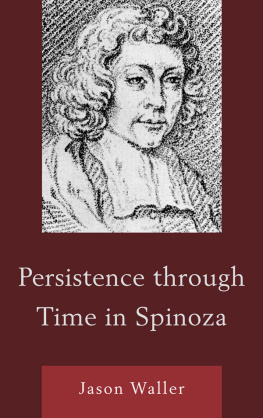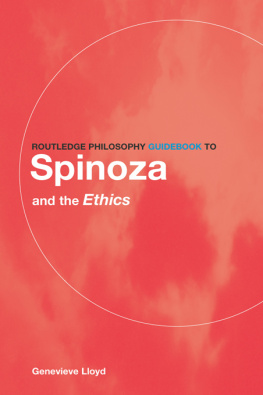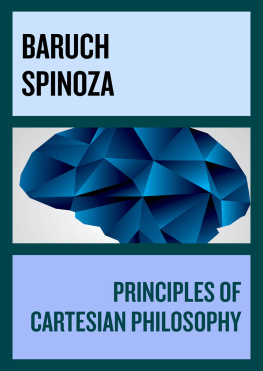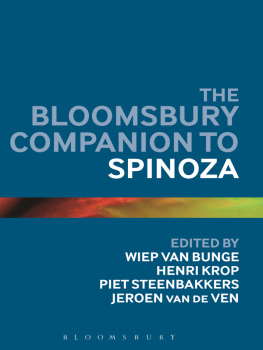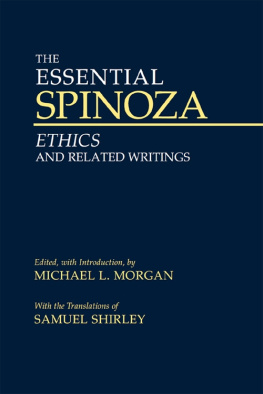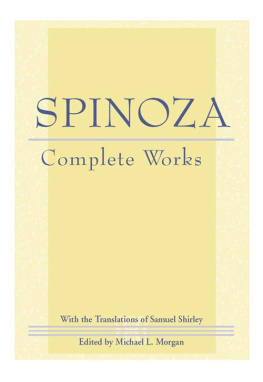Spinoza Benedictus de - Persistence through Time in Spinoza
Here you can read online Spinoza Benedictus de - Persistence through Time in Spinoza full text of the book (entire story) in english for free. Download pdf and epub, get meaning, cover and reviews about this ebook. City: Lanham, year: 2012, publisher: Lexington Books, genre: Religion. Description of the work, (preface) as well as reviews are available. Best literature library LitArk.com created for fans of good reading and offers a wide selection of genres:
Romance novel
Science fiction
Adventure
Detective
Science
History
Home and family
Prose
Art
Politics
Computer
Non-fiction
Religion
Business
Children
Humor
Choose a favorite category and find really read worthwhile books. Enjoy immersion in the world of imagination, feel the emotions of the characters or learn something new for yourself, make an fascinating discovery.
- Book:Persistence through Time in Spinoza
- Author:
- Publisher:Lexington Books
- Genre:
- Year:2012
- City:Lanham
- Rating:3 / 5
- Favourites:Add to favourites
- Your mark:
- 60
- 1
- 2
- 3
- 4
- 5
Persistence through Time in Spinoza: summary, description and annotation
We offer to read an annotation, description, summary or preface (depends on what the author of the book "Persistence through Time in Spinoza" wrote himself). If you haven't found the necessary information about the book — write in the comments, we will try to find it.
Persistence through Time in Spinoza — read online for free the complete book (whole text) full work
Below is the text of the book, divided by pages. System saving the place of the last page read, allows you to conveniently read the book "Persistence through Time in Spinoza" online for free, without having to search again every time where you left off. Put a bookmark, and you can go to the page where you finished reading at any time.
Font size:
Interval:
Bookmark:
Persistence through Time in Spinoza
Persistence through Time in Spinoza
Jason Waller
LEXINGTON BOOKS
Lanham Boulder New York Toronto Plymouth, UK
Published by Lexington Books
A wholly owned subsidiary of The Rowman & Littlefield Publishing Group, Inc.
4501 Forbes Boulevard, Suite 200, Lanham, Maryland 20706
www.rowman.com
10 Thornbury Road, Plymouth PL6 7PP, United Kingdom
Copyright 2012 by Lexington Books
All rights reserved. No part of this book may be reproduced in any form or by any electronic or mechanical means, including information storage and retrieval systems, without written permission from the publisher, except by a reviewer who may quote passages in a review.
British Library Cataloguing in Publication Information Available
Library of Congress Cataloging-in-Publication Data
Waller, Jason.
Persistence through Time in Spinoza by Jason Waller.
p. cm.
Includes bibliographical references (p. ) and index.
ISBN 978-0-7391-7002-1 (cloth : alk. paper) ISBN 978-0-7391-7003-8 (electronic)
1. Spinoza, Benedictus de, 16321677. 2. TimePhilosophy. 3. Persistence. I. Title.
B3999.T4W35 2012
199'.492dc23
2012018319
 The paper used in this publication meets the minimum requirements of American National Standard for Information Sciences Permanence of Paper for Printed Library Materials, ANSI/NISO Z39.48-1992.
The paper used in this publication meets the minimum requirements of American National Standard for Information Sciences Permanence of Paper for Printed Library Materials, ANSI/NISO Z39.48-1992.
Printed in the United States of America
I would like to thank many scholars for their generous support over the past few years. First, I would like to thank Jan Cover, Daniel Frank, and Mike Jacovides for their great help in working out the ideas presented in this book while studying at Purdue. This book also benefited at different stages by the work of numerous anonymous reviewers. I would also like to thank my fellow Purdue Spinoza scholars Chris Martin and Thad Robinson for many wonderful conversations. I learned a great deal about Spinoza from both of them. Finally, I would like to thank my beautiful and brilliant wife, Rebecca, for her love, support, and help in understanding the finer points of Descartess philosophy.
Some of this material has been published elsewhere. A few paragraphs from my paper Spinoza on the Incoherence of Self-Destruction, British Journal for the History of Philosophy 17(3) 2009: 507523 are reprinted in chapter 2. A version of chapter 3 was previously published as Spinoza on the Illusion of Temporal Passage, Iyyun: The Jerusalem Philosophical Quarterly (59) 2010: 4762. A version of chapter 4 has also been published as Spinoza on Conatus and Persistence Through Time, Journal of Philosophical Research, 37: 51-72. I would like to thank these journals for permission to reprint this material.
This book concerns ordinary cases of persistence through time in Spinozas metaphysics. In this first chapter, I begin by outlining (i) the problem of persistence, (ii) Spinozas theory of bodies, (iii) the three general solutions to the problem of persistence (endurance, perdurance, and exdurance), and (iv) the central argument of this book. My goal in this chapter is to make the relevant background material accessible to the non-specialist. I will, therefore, largely sidestep technical scholarly disputes and citations. I reserve these issues for the following chapters.
The problem of persistence arises from the acceptance of four mutually inconsistent theses all of which seem to be true:
Consistency Thesis: No body can have incompatible properties. That is, no body x can both have and not have some property F.
Identity Thesis: If x is identical to y, then x and y have all of the same properties.
Change Thesis: All changes involve incompatible properties. That is, a body x changes when it goes from having property F to not having F (or vice versa).
Survival Thesis: Bodies survive change. The body x which has property F at time t1 is identical to the body x which does not have property F at time t2.
These four theses generate a paradox because although they are all highly intuitive, it seems as though they cannot all be true. Consider, for example, a candle which goes from being straight at time t1 to being bent at time t2. Has the candle survived this change in shape? It seems as though it could not have. In order to survive the change the candle at time t2 must be identical to the candle at time t1 (by the Survival Thesis). But then (by the Identity Thesis) the straight-candle and the bent-candle must have all of the same properties. But the straight-candle and the bent-candle cannot have all of the same properties because the properties of being straight and being bent are incompatible (by the Change Thesis) and no thing can have incompatible properties (by the Consistency Thesis). To claim that the candle has survived this change is to commit ones self to a contradiction by claiming that something has incompatible properties (i.e., is both straight and bent). Thus, to avoid the contradiction it seems as though we must say that the candle has been destroyed by the bending and a numerically distinct (but similar looking) new candle has been created.
The conclusion that the candle has not survived the bending is strange. But if this reasoning is correct, then the consequences of this strange conclusion are quite troublesome. For example, the same kind of reasoning could apply to every change (no matter how small) that anything undergoes. Thus, we would be committed to claiming that nothing can survive any change. All change destroys the thing changed! To see just one weird consequence of this conclusion consider a person, named Bob, who is filling out the paperwork to take out a loan from a bank at 10:30am while seated in a chair. At 10:31 Bob signs the forms, stands up, shakes the bankers hand, and receives the check. After receiving the check Bob claims to not be the person who was sitting in the chair a moment ago (how can he be, being seated and being standing are incompatible properties?) and thus he, the standing Bob, is not responsible for the loan that other guy signed for. Certainly no one is responsible for a loan that someone else took outno matter how much that other person resembles you! Unless the guy in the chair who signed for the loan is identical to the guy now standing, the guy now standing is not responsible for the loan. But the conclusion that standing-Bob is not responsible for the loan that sitting-Bob signed for is ridiculous. Thus, there must be something wrong with the initial line of reasoningone of the four highly intuitive theses must be false. But which one? A theory of persistence is a theory which explains how it is possible for bodies to persistence through (at least some) changes without being destroyed. A theory of persistence must do two things: (i) it must explain which of the four intuitive theses is false and (ii) it must explain how some kind of persistence or survival is still possible without that thesis.
The problem of persistence is a particularly difficult problem for Spinoza. The problem is tricky because Spinoza argues for a unique theory of bodies whereby they are modes or modifications of space (i.e., substance). In this section I outline Spinozas unique theory of bodies in an intuitive way and show why the problem of persistence is such a difficult problem for him to solve. I am not concerned here with refuting alternative scholarly interpretations (although I will note a few important controversies in passing). Instead my aim is to introduce the non-specialist to the core ideas of Spinozas theory of bodies.
Next pageFont size:
Interval:
Bookmark:
Similar books «Persistence through Time in Spinoza»
Look at similar books to Persistence through Time in Spinoza. We have selected literature similar in name and meaning in the hope of providing readers with more options to find new, interesting, not yet read works.
Discussion, reviews of the book Persistence through Time in Spinoza and just readers' own opinions. Leave your comments, write what you think about the work, its meaning or the main characters. Specify what exactly you liked and what you didn't like, and why you think so.

